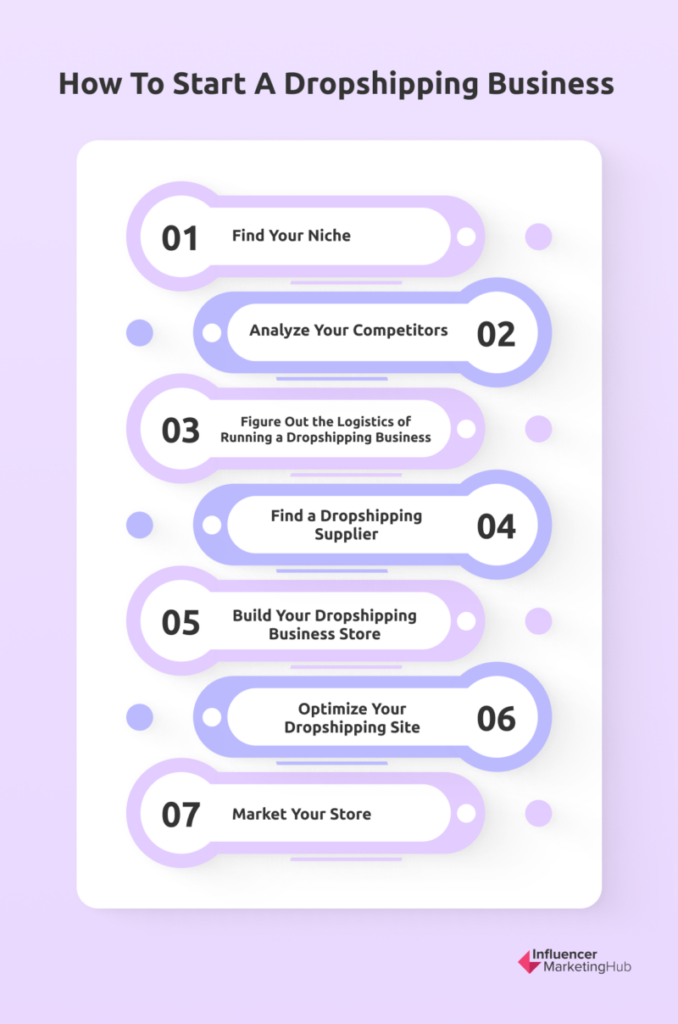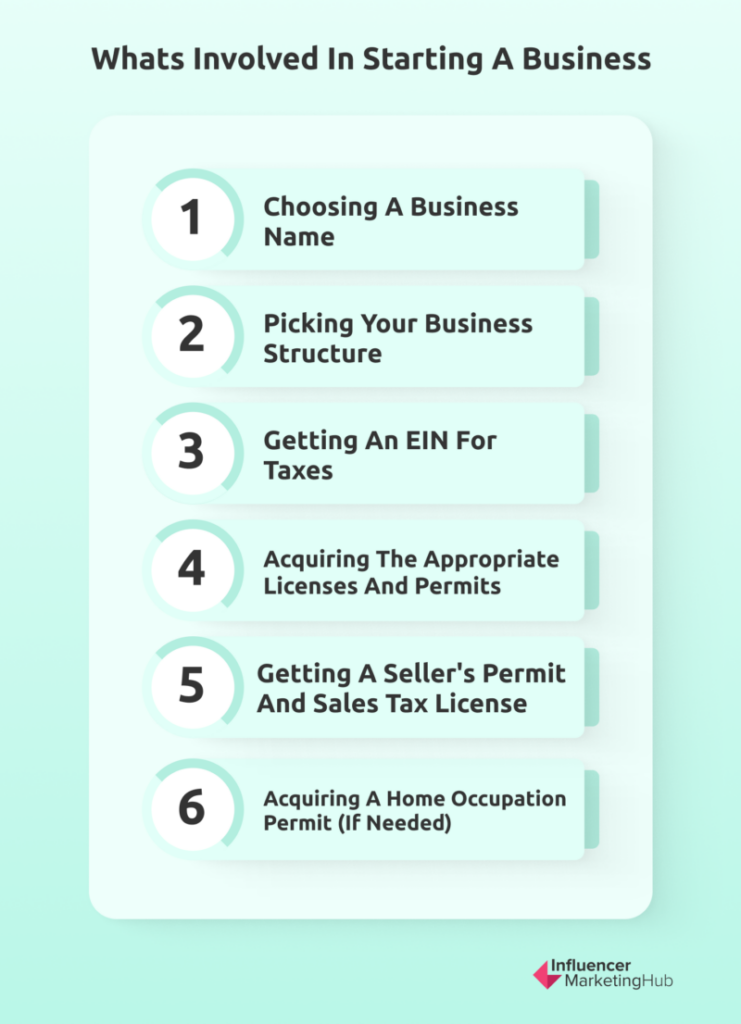Considering dipping your toes into the world of online business but feel overwhelmed about where to begin? Or maybe you're already running multiple businesses but want to try your hand at eCommerce to develop another income stream. Either way, dropshipping might be the solution you're looking for. In this article, we'll teach you how to start a dropshipping business of your very own, quickly and easily. If you've never even heard of dropshipping, don't worry. We're going to get started by covering what dropshipping is, how it works, and why you should start your own dropshipping business. From there, we'll walk you through what you need to know to build your eCommerce empire from the ground up.
Let's get started!
How to Start a Dropshipping Business in 2024:
What Is Dropshipping and How Does It Work?
Dropshipping is an eCommerce business model in which store owners (you) sell directly to consumers (the people who buy from you) without stocking any inventory. A customer purchases a product from your dropshipping store and a third-party supplier ships the item directly to the customer. The customer pays whatever price you set and you pay the supplier's wholesale price—the rest is yours to keep (your profit).
Why Start a Dropshipping Business?
Entrepreneurs love dropshipping because of the low risk involved. You don't have to create and produce products, store inventory, package and ship the products. You just sell them and pay the supplier their cut. There are even dropshipping suppliers who handle the customer service, too, so if something goes wrong, they even deal with the customers to resolve the issue.
It's a ridiculously easy way to start an eCommerce business.
How to Start a Dropshipping Business
Ready to get started with your own dropshipping business? Here are the steps you need to take to get off on the right foot.

Find Your Niche

The first thing to do when starting a dropshipping business is to decide what you're going to sell. This doesn't mean you have to decide on each and every product right away, but it does mean that you'll want to pick a niche that interests you and that will actually make money. We've found that it's easiest to make a list of your interests and passions, as well as thinking about the people you want to sell to. Here are a few examples of profitable dropshipping niches to consider in 2024:
- Home improvement
- Sports and entertainment
- Lights/lighting
- Smart home appliances
- Tools
Sports and entertainment usually make these lists, but with the year we just came out of, it's probably not surprising that people have gravitated towards home improvement and related items in their purchases. But if nothing there is catching your eye, here are some of the tried-and-true dropshipping niches:
- Health and beauty
- Jewelry
- Clothing
- Home decor
- Garden tools and supplies
- Pregnancy, babies, and children
- Phone-related products
- Toys and games
- Food and drink
Analyze Your Competitors
Once you've settled on a niche, you'll want to learn who your competitors are in that niche and take a look at what they're doing. You can do this in several different ways. Here are the top two ways we recommend you find your competitors.
- Google Search. Search for one of the products you want to sell and see who comes up in the top ten results on Google. This will let you know who your competitors are so you can check out their sites and see how they're marketing their brand and running their business.
- Third-Party Tools. Tools like SEMrush, Alexa, and SimilarWeb are great ways to find competitors in your niche that you may miss with a standard Google search. With these tools, you'll be able to get more information about your competitors like how much traffic they get, their social media profiles, and what advertising they do.
After you know who you're up against, you can use social listening tools to dig deeper into their dropshipping process so you can replicate it and do it even better.
Figure Out the Logistics of Running a Dropshipping Business

By now, you should know what niche you want to sell in, have a few products in mind, and know more about your competitors (and whether your niche is profitable). Next, you'll need to navigate the logistics of starting and running your own business. This involves:
- Choosing a business name
- Picking your business structure (sole proprietorship, LLC, etc.)
- Getting an EIN for taxes (if needed)
- Acquiring the appropriate licenses and permits as required by your federal, state, and local governments
- Getting a seller's permit and sales tax license
- Acquiring a home occupation permit (if needed) to do business from your home
It's a lot to think about. Just check with each level of government and complete the necessary steps as you come to them. And find an accountant to work with—it will make your life a whole lot easier.
Find a Dropshipping Supplier
Now it's time to find a dropshipping supplier. If you're using a platform like Oberlo or Spocket, you'll find a list of suppliers within those platforms. Otherwise, you'll need to find dropshippers on your own, which can be a daunting task since there are hundreds (maybe thousands) of them. Here's what to look for when choosing the right supplier for you no matter whether you're using a dropshipping platform or going it alone:
- Experience. How long has the dropshipping supplier been in business? What's their Net Promoter Score? How do they fare with the Better Business Bureau and on TrustPilot? Can they give you referrals?
- Product Samples. One of the biggest complaints about dropshippers is that the products are of poor quality. Before finalizing an agreement with a supplier, request samples of the products you're interested in selling so you can compare them to your other options.
- Shipping. Most dropshipping suppliers seem to be located in China, so it can take time for products to get from them to your customers. Check delivery times to make sure that your customers won't be waiting more than 1–2 weeks for their purchases.
- Fees. Dropshipping margins are low, making it incredibly important that the supplier you choose doesn't charge exorbitant fees. According to SalesHoo, you shouldn't pay more than $5 per item for stocking, packaging, and shipping outside of the (small) monthly fee a supplier might charge to work with them.
Build Your Dropshipping Business Store
So far, you've found a niche, figured out if it's profitable (through competitor research), and found a dropshipping supplier to work with. Next up, you need a store where people can actually buy your awesome products. If you're going with Oberlo, you're going to need a Shopify store. With Spocket or other dropshipping marketplaces, you'll have different eCommerce platforms to choose from.
To put together your dropshipping store, here's what you'll need:
- A domain name (get a .com)
- A backend platform (Shopify, WooCommerce, BigCommerce, etc.)
- A design
Once you've got those three things set up, you're ready to start adding your products into your store.
Optimize Your Dropshipping Site
After you launch your site, you're done, right? You just sit back and wait for the money to come pouring in?
Not quite.
Once you've chosen your eCommerce platform and launched your online store, it's time to optimize your site so your customers have a better chance of finding you in the giant ocean that is the internet. And, not only will you need to optimize your store to be found, you'll need to optimize it for conversions, too. First, let's talk about SEO for dropshipping.
SEO
Here are a few ways you can optimize your dropshipping site for SEO and get it to turn up higher in search engine results:
- Keywords. Search engines use the text on your website's pages to decide how to index your pages for certain searches. These days, long-tail keywords are the norm; not only are they more specific ("best dropshipping marketplaces" instead of just "dropshipping," for instance) but they're better for voice search.
- Backlinks. Backlinks are links to your website from other, external sources. They're also an SEO ranking signal. While it's better to get other sites to link back to your site, you can also take advantage of backlinks by linking to your own site from your social media accounts, your YouTube channel, and other platforms where you share content you create.
- Blog. Blogging gives you more content on your site, giving search engines that much more content to index and show off in their search results pages. Blogging is also great for keeping customers and visitors on your site longer which signals to search engines that visitors find your content useful. This means that they're more likely to show your content higher in search results.
Check out these SEO tools to help you find ideas for keywords to target.
Conversions
Optimizing for conversions generally has to do with removing friction for customers. This might mean reducing the number of steps it takes to take an action on your site or even changing something as seemingly mundane as your button colors to make them more appealing. Here are two of our favorite ways to optimize a dropshipping store for conversions.
- Take shoppers directly to their cart. We all want to think that our eCommerce store is like Target. Shoppers come in to grab what they want but decide to browse around, ending up at the checkout with $200 worth of products they didn't know they wanted. Instead, your dropshipping site is more like a dentist's office—come in, get what you needed, and leave. Embrace that. Once shoppers add what they want to their cart, take them right to the checkout stage. Offer an upsell from there, but make it easy to stay in the checkout process.
- Add trust badges. Trust badges let visitors to your dropshipping store know that it's safe to buy from you. They can include payment gateway logos, and other marks (see below) to inspire confidence in buying from you.
Market Your Store
The last step in how to start a dropshipping business is marketing. There are literally endless ways to market your store, from email marketing to paid ads to social media and everything in between. Marketing your store is going to take time and effort... possibly a little money. But it's worth it to bring in a steady flow of traffic and get purchases rolling. You absolutely cannot just wait for people to stumble into your store. There is no foot traffic here.
We're going to look at our top three ways to market your dropshipping store.
Email Marketing
Email marketing is one of the most powerful marketing methods around. In addition to the standard email newsletter, we recommend that you include these emails in your email marketing strategy:
- Welcome emails. After someone signs up for your email newsletter they expect to hear from you. We recommend sending a welcome email series for 3–5 emails to introduce subscribers to you and your brand as well as letting them know what to expect.
- Discounts and special offers. Discounts and promotional offers are a great way to endear your subscribers to you. Everybody loves saving money. Don't forget special promotions for holidays!
- Abandoned cart emails. Whenever you can, it's important to send abandoned cart recovery emails. Abandoned carts occur when a shopper adds an item to their cart then leaves your store without completing their purchase. Recovery emails can mean the difference between losing a sale and making one.
- Review requests. Testimonials and reviews are the social proof you need to add more trustworthiness to your store. To get them, send emails to your customers and just ask
Social Media
Social media is another powerful way to get customers interested in what you have to offer. Here's what we recommend to get your dropshipping business noticed on social media:
- Post great content (including product pictures). The primary purpose of social media is to get attention for your brand. That's a whole lot easier when you share interesting content and images.
- Embrace video. Videos are even better than images at showing off your products. Start with a few educational videos showing potential customers how to use your products.
- Engage with your followers. Social media is social! Too many brands forget to engage with their followers, making their social media accounts, well, not that fun. Try to reply to comments and keep interest in your brand and products high.
- Use influencers. It shouldn't surprise you that we at Influencer Marketing Hub recommend the use of influencers. To find the right influencer for your brand, look for influencers who have an audience that overlaps yours. Influencers can help you get user-generated content to share with your followers, send traffic to your store, and a lot more.
Enjoy eCommerce Success With Dropshipping
A dropshipping business can be a fun and easy way to get started with eCommerce. Many dropshippers start their business as a side hustle, still maintaining a full-time job and using the income from the dropshipping business to supplement their income but others go full bore into their dropshipping business and turn them into quite lucrative businesses.
Frequently Asked Questions
How much does it cost to start a dropshipping business?
You can start your own dropshipping business for as little as $100, which makes it a great low-cost business idea. Dropshippers can sell an entire range of different products without processes or holding any inventory.
How can a beginner start dropshipping?
How to start a dropshipping business in 5 easy steps:
- PIck a niche and conduct a market analysis
- Find a dropshipping supplier
- Build an online store
- Register your business as a legal structure
- Optimize and market your brand to drive sales
How much can Beginner dropshippers make?
You can generate $1,000 to $2,000 a month within the first 12 months as a beginner dropshipper. This will require around 10 to 15 hours of work per week to build the business.
Is dropshipping still a profitable business?
Dropshipping is absolutely still worth the investment for people seeking a low-cost business idea. Searches for “dropshipping” have increased exponentially in recent years. The success comes down to picking the right products, keeping an eye on profit margins, and picking the right suppliers.


